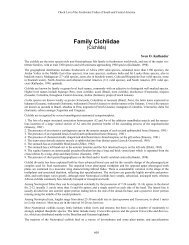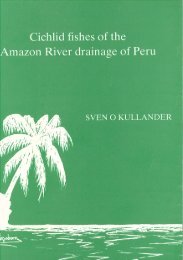Open Access PDF - Sven Kullander
Open Access PDF - Sven Kullander
Open Access PDF - Sven Kullander
You also want an ePaper? Increase the reach of your titles
YUMPU automatically turns print PDFs into web optimized ePapers that Google loves.
Fig. 19. Cichla orinocensis, MNHN A.1042, ca. 375 mm SL; Brazil; holotype of Cichla argus. Photograph by E. Åhlander.<br />
Fig. 20. Cichla cf. orinocensis, MBUCV-V 10287, 1, 82.3 mm SL; Venezuela: Bolívar, Rio Cuyuni, Raudal de Kinotovaca,<br />
ca. 40 km south of El Dorado.<br />
ing from the Musée de Lisbonne, and probably<br />
represents part of the Brazilian fish collection<br />
made by A. Ferreira 1783-1792. His collection,<br />
originally kept in Lisboa, was confiscated by the<br />
French army in 1807 and taken to Paris (Araújo,<br />
1983).<br />
The names C. orinocensis and C. argus were<br />
published simultaneously, and C. orinocensis has<br />
priority by action of the first reviser, Günther<br />
(1862: 309), who listed both names in the synonymy<br />
under Crenicichla orinocensis. We do not<br />
designate a neotype of C. orinocensis here because<br />
there is currently no nomenclatural problem associated<br />
with the species.<br />
Cichla orinocensis was identified as a Crenicichla<br />
Ichthyol. Explor. Freshwaters, Vol. 17, No. 4<br />
313<br />
species by Günther (1862), probably inspired by<br />
the elongate shape of the specimen illustrated<br />
by Humboldt (1821). Later authors (e.g., Regan,<br />
1906) synonymized C. orinocensis with C. ocellaris.<br />
Machado-Allison (1971, 1973) provided the so far<br />
most detailed descriptive information on C. orinocensis,<br />
under the name C. ocellaris. Román (1981)<br />
treated the general natural history of the species<br />
with many illustrations, also as C. ocellaris. Ecological<br />
aspects are covered by Winemiller (2001).<br />
Machado-Allison (1971: 468, figs. 3-4) described<br />
and figured the colour ontogeny of<br />
C. orinocensis from juvenile to adult, corresponding<br />
to the description given above. The largest<br />
specimen listed in Machado-Allison’s table of




